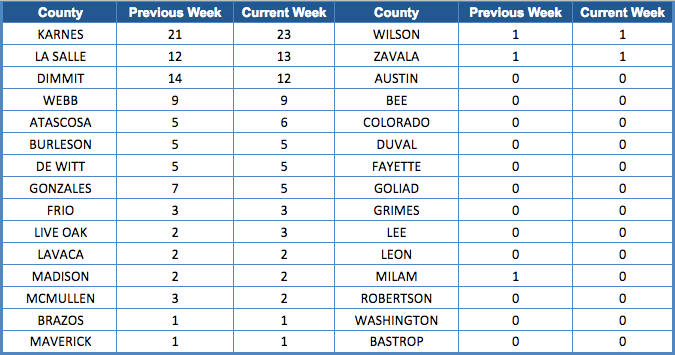The Eagle Ford Shale rig count inched up this week after waffling for weeks. Our data shows 96 rigs running across our coverage area by midday Friday.
In recent Eagle Ford Shale news, the Energy Information Administration (EIA) is predicting a 43 thousand barrel a day increase for crude oil produced in the Eagle Ford Shale for July.
Read more: Eagle Ford Oil Production Up
A total of 952 oil and gas rigs were running across the United States this week, a decrease of one over last week. 189 rigs targeted natural gas (five more than the previous week) and 763 were targeting oil in the U.S. (seven more than the previous week). The remainder were drilling service wells (e.g. disposal wells, injection wells, etc.) 463 of the rigs active in the U.S. were running in Texas.
Baker Hughes reports its own Eagle Ford Rig Count that covers the 14 core counties. The rig count published on EagleFordShale.com includes a 30 county area impacted by Eagle Ford development. A full list of the counties included can be found in the table below.
Eagle Ford Oil & Gas Rigs
Eight rigs in the Eagle Ford region targeted natural gas this week with the commodity trading lower at $2.86/mmbtu.
88 Eagle Ford rigs were targeting oil with WTI oil prices at $44.23.
A total of 93 rigs are drilling horizontal wells, zero are drilling directional wells and three are vertical.
Karnes County leads this week with 23 rigs in production. See the full list below in the Eagle Ford Shale Drilling by County below.
Eagle Ford Shale Drilling by County
Eagle Ford Rig Count by County-July 9, 2017
Eagle Ford Shale News
Sanchez Energy Sells Eagle Ford Assets
Methane Levels in Eagle Ford Water Insignificant
NAFTA Revision Could Mean Energy Independence
What is the Rig Count?
The Eagle Ford Shale Rig Count is an index of the total number of oil & gas drilling rigs running across a 30 county area in South Texas. The South Texas rigs referred to in this article are for ALL drilling reported by Baker Hughes and not solely wells targeting the Eagle Ford formation. All land rigs and onshore rig data shown here are based upon industry estimates provided by the Baker Hughes Rig Count.






